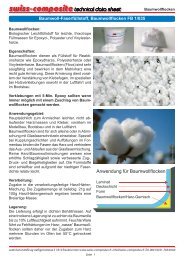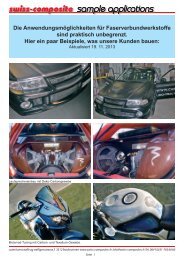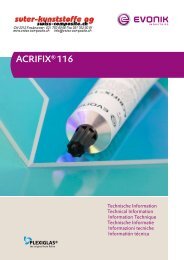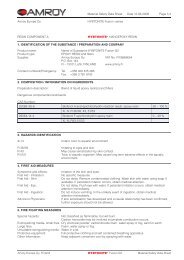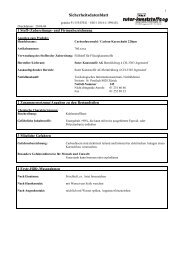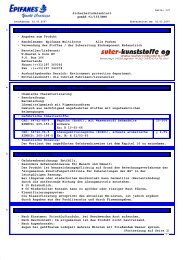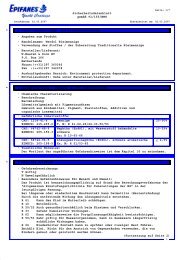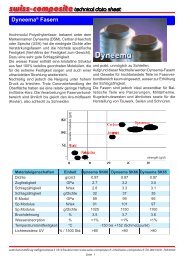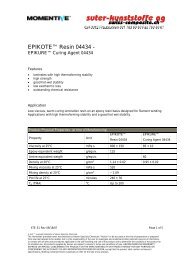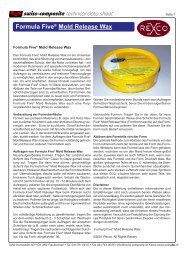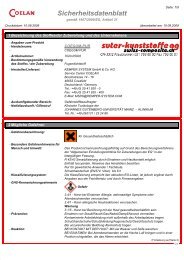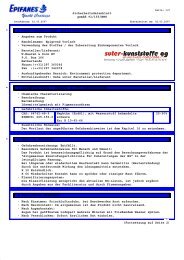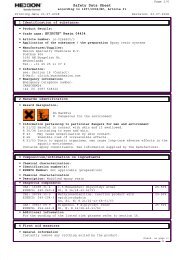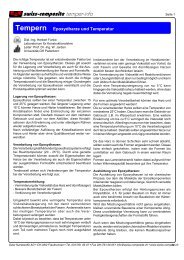Handbuch - Suter Swiss-Composite Group
Handbuch - Suter Swiss-Composite Group
Handbuch - Suter Swiss-Composite Group
Sie wollen auch ein ePaper? Erhöhen Sie die Reichweite Ihrer Titel.
YUMPU macht aus Druck-PDFs automatisch weboptimierte ePaper, die Google liebt.
8<br />
KOHLENSTOFFASERN (CARBON) HERSTELLUNG UND EIGENSCHAFTEN<br />
CARBON FIBRES MANUFACTURE AND PROPERTIES<br />
Kohlenstoffasern wurden (als Glühlampendraht) erstmals im 19. Jahrhundert<br />
durch Verkokung von Kunstseide erzeugt.<br />
Erst viel später, gegen Ende der 60er Jahre kamen Kohlenstoff-Verstärkungsfasern<br />
in geringen Mengen und zu hohen Preisen (um 1500,-- EUR / kg) auf den<br />
Markt. Zunächst waren lediglich Rovings (endlose Faserstränge) verfügbar,<br />
die in der Luft- und Raumfahrt eingesetzt wurden.<br />
Seit etwa 1975 werden Kohlenstoffasern weltweit in industriellem Maßstab<br />
gefertigt und zu vielfältigen textilen Verstärkungsmaterialien verarbeitet.<br />
Tenax ®<br />
Tenax ® ist eine aus Polyacrylnitril (PAN) Precursor hergestellte Hochleistungskohlenstoffaser,<br />
die sich durch hohe Festigkeit, hohen Elastizitätsmodul und<br />
niedrige Dichte auszeichnet.<br />
Seit 10 - 15 Jahren wird die Kohlenstoffaser in wachsendem Umfang in<br />
Hochleistungsverbundwerkstoffen eingesetzt. Dieser moderne Werkstoff wird<br />
mittlerweile in vielen Industriezweigen, wie z.B. der Luftfahrtindustrie, dem<br />
Maschinenbau, der Automobilindustrie, dem Schiffbau, der Medizintechnik,<br />
der Windenergie, der Off-Shore- und nicht zuletzt der Sportartikelindustrie<br />
eingesetzt.<br />
Die Tenax ® Kohlenstoffaser hat durch ihre bewährten Eigenschaften im Verbundwerkstoff<br />
in Verbindung mit einem äußerst kundenorientierten<br />
kommerziellen und technischen Service eine führende Marktposition in Europa<br />
erobern können. In Kombination mit einem ausgereiften Massenproduktionsprozess<br />
kann Tenax Fibers immer neue Anwendungen für die Kohlenstoffaser<br />
erschließen. Daher stehen Tenax ® Kohlenstoffasern an vorderster Stelle, wenn<br />
eine kosteneffiziente Anwendung von Carbon verlangt wird.<br />
Eigenschaften<br />
Mechanische und dynamische Eigenschaften<br />
Hohe Festigkeit<br />
Hoher Elastizitätsmodul<br />
Niedrige Dichte<br />
Geringe Kriechneigung<br />
Gute Schwingungsdämpfung<br />
Geringe Materialermüdung<br />
Die Festigkeiten übertreffen die der meisten Metalle und anderer Faserverbundwerkstoffe.Die<br />
Dehnung von CFK ist vollelastisch, Ermüdungsbeständigkeit<br />
und Vibrationsdämpfung sind hervorragend.<br />
Chemische Eigenschaften<br />
Chemisch inert<br />
Nicht korrosiv<br />
Hohe Beständigkeit gegen Säuren, Alkalien und<br />
organische Lösungsmittel<br />
Chemisch sehr inert, hohe Widerstandsfähigkeit gegenüber den meisten Säuren,<br />
Alkalien und Lösungsmitteln. Kohlenstoffasern nehmen praktisch kein Wasser<br />
auf.<br />
8.24<br />
KOHLENSTOFFASERN (CARBON) CARBON FIBRES<br />
The first carbon fibres were manufactured in the nineteenth century when<br />
artificial silk (today called rayon) was carbonised to produce filaments for<br />
incandescent lamps. Not until much later, towards the close of the sixties, did<br />
reinforcing carbon fibres make an entry on the market – in small quantities<br />
and at staggeringly high prices (about EUR 1,500 per kilogram).<br />
The first of these carbon fibres were available solely in the form of continuous<br />
rovings that were used in the aerospace industries. Since about 1975 carbon<br />
fibres are being produced throughout the world on an industrial scale and<br />
processed to serve as flexible textile reinforcing materials.<br />
Tenax ®<br />
Tenax ® is a high-performance carbon fibre that is produced from a<br />
polyacrylonitrile (PAN) precursor and whose characteristic features are high<br />
strength, high modulus of elasticity, and low density. Over the last ten to<br />
fifteen years, the proportion of carbon fibres in high-performance composites<br />
has been experiencing a steady growth. This new material is now being used<br />
in many branches of industry, e.g. aviation, machine construction, car<br />
manufacture, shipbuilding, medical engineering, wind energy, offshore<br />
installations, and - not least of all - sports articles.<br />
With its tried-and-tested properties in the composite in conjunction with<br />
highly customer-oriented commercial and technical services, Tenax ® carbon<br />
fibres have succeeded in adopting a leading market position in Europe.<br />
In combination with a matured mass production process, the Tenax Fibers<br />
company is constantly developing new applications for carbon fibres. So<br />
Tenax ® carbon fibres are at the top of the list whenever applications demand<br />
carbon for cost-effectiveness.<br />
Properties<br />
Mechanical and dynamic properties<br />
High strength<br />
High modulus of elasticity<br />
Low density<br />
Low tendency to creep<br />
Good vibration damping<br />
Low material fatigue<br />
The strength values exceed those of most metals and other fibre composites.<br />
CRP exhibits fully elastic elongation as well as outstanding fatigue strength<br />
and vibration damping.<br />
Chemical properties<br />
Chemically inert<br />
Non-corrosive<br />
Highly resistant to acids, alkalis, and organic solvents<br />
Highly inert with respect to chemicals and highly resistant to most acids,<br />
alkalis, and solvents, carbon fibres absorb practically no water.<br />
R&G Faserverbundwerkstoffe GmbH D-71111 Waldenbuch Fon 0 71 57/53 04 60 Fax 0 71 57/53 04 70 www.r-g.de<br />
Ausg./Ed. 01.03 Änderungen vorbehalten / Modifications reserved



